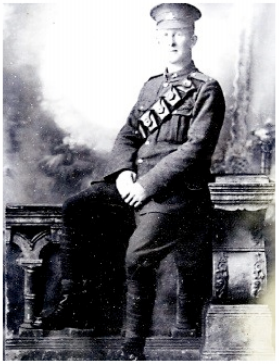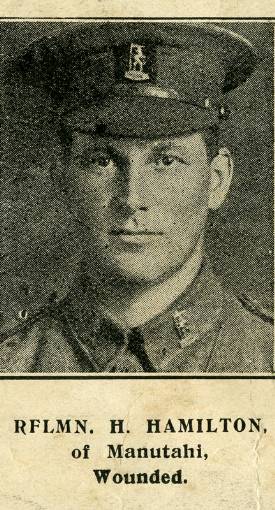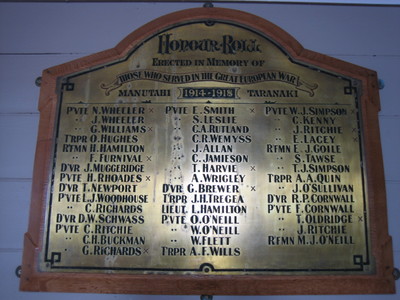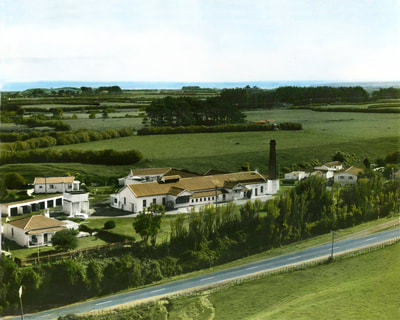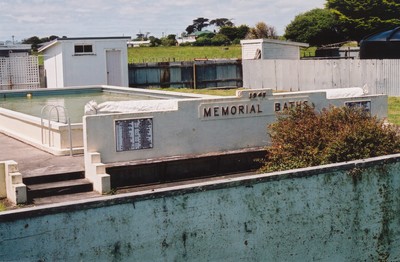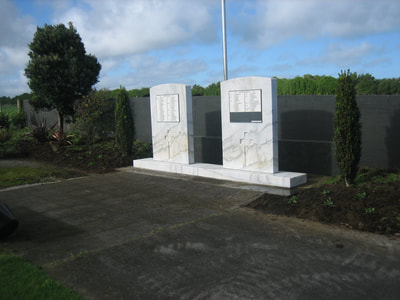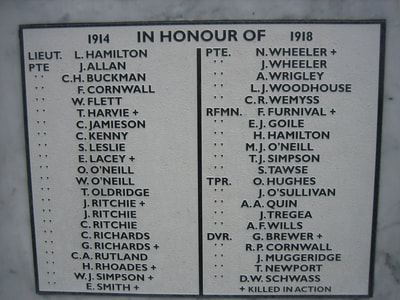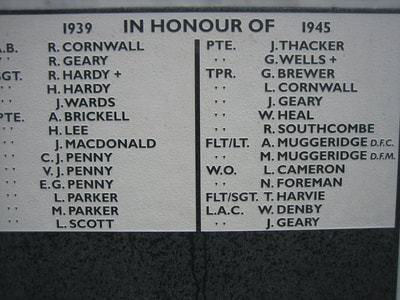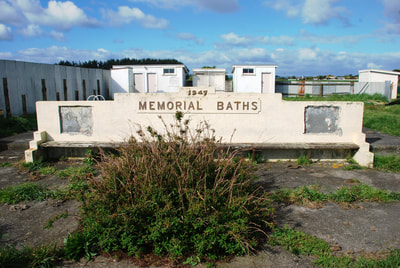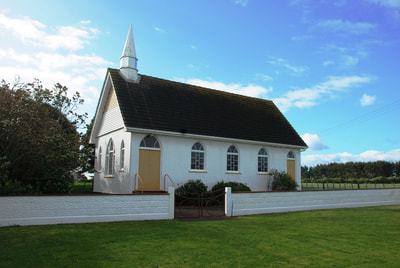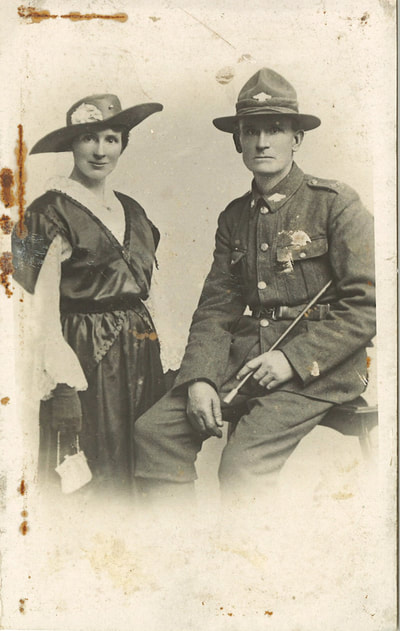|
Manutahi WWI Soldiers
James ALLAN, Corporal, 28063 Enlistment address on war records is Manutahi Cyril Henry BUCKMAN, Private, 20294 Son of Joseph and Mary Buckman Andrew CADMAN, Bombardier, 11/2052 MM Son of George and Esther Margaret Cadman Robert Patrick CORNWALL, Driver, 50865 Son of Robert and Mary Cornwall Francis CORNWALL, Private, 64459 Son of Robert and Mary Cornwall William FLETT, Private, 44362 Son of William Flett, Hayfield Cottage, Lerwick, Shetland Islands, Scotland Edger John Bennett GOILE, Rifleman, 56762 Son of Edward Henry Julius and Beatrice Goile Harold HAMILTON, Rifleman, 24/1067 Son of Richard Blair and Elizabeth Mary Hamilton Leslie Richard HAMILTON, Lieutenant, 33081 Son of Richard Blair and Elizabeth Mary Hamilton Oswald HUGHES, Trooper, 11/1715 Son of Esther Hughes, 34 Fleetwood Road, Dollas Hill, London, England C JAMIESON, Charles Edward Trevelyan KENNY, Private, 51312 Son of Francis Trevelyan and Julianna Kenny Samuel LESLIE, Private, 28161 Born in Scotland, Cheesemaker at Manutahi Factory John MUGGERIDGE, Driver, 5/537 Son of Alfred and Elizabeth Eliza Echard Muggeridge Thomas Henry NEWPORT, Rifleman, 24/250 Son of George Newport, Barrow, near Chester, England Owen Eugene O’NEILL, Private, 38206 Son of Patrick and Nora O’Neill William O’NEILL, Private, 39490 Son of Patrick and Nora O’Neill Michael James O’NEILL, Private, 62129 Son of Patrick and Nora O’Neill John O’SULLIVAN, Trooper, 57593 Son of Michael and Elizabeth O'Sullivan Alfred Augustine QUIN, Trooper, 43699 Son of Charles and Jane Elizabeth Ryans Quin, husband of Catherine Boyle Quin Charles Edward RICHARDS, Private, 22861 Son of Thomas and Susan Richards, Rangiora. Charles RITCHIE, Private, 20422 Son of William and Carolina Ritchie James RITCHIE, Private, 57563 Son of William and Carolina Ritchie Cyril Arthur RUTLAND, Private, 28210 Son of Walter George and Mary Rutland David William SCHWASS, Driver, 13238 Son of Christopher Frederick and Emma Elizabeth Schwass Thomas John Gair SIMPSON, Rifleman, 56862 Son of Thomas John Gair and Sarah Jane Simpson Samuel TAWSE, Rifleman, 56872 Son of Mrs Jessie Tawse, Born in Scotland James Henry TREGEA, Trooper, 41668 Son of Arthur and Agnes Tregea Colin Roland WEMYSS, Private, 28248 Son of David and Helen Wemyss John Thomas WHEELER, Trooper, 11/871A Son of James and Annie Wheeler Alan Frederick WILLS, Trooper, 74902 Son of Albert Edward and Charlotte Alice Wills Lawrence John WOODHOUSE, Rifleman, 24/330 Born in Lancaster, England Alexander William WRIGLEY, Rifleman, 37028 Husband of Mrs Mary Jane Wrigley Killed in Action WWI: *George Thomas BREWER, Driver 30470, 11th Btn, NZ Field Artillary Died at age 35 on 5 April 1918 At Somme, France Occupation before enlistment: Farmer for JR Taylor, Taumaha Road Son of Richard and Alice Brewer, Lancashire, England *Frederick William FURNIVAL, Sergeant, 24/1048 New Zealand Rifle Brigade, 2nd Battalion, D Company Occupation before enlistment: Farmed for Mr Wills, Manutahi Died at age: 27, on 20 May 1918 in France Son of Frederick and Agnes Furnival, Surrey, England *Thomas HARVIE, Rifleman, 30370 11th Reinforcements 4th Battalion, (H Company) Occupation before enlistment: Hotel Keeper, Manutahi Died at age 58, on 12 August 1917 at Ypres, Belgium Wife, Mrs Annie Elizabeth Harvie, Manutahi Hotel *Edward LACEY, Rifleman, 52844 NZ Rifle Brigade, 2nd Battalion Occupation before enlistment: Farm Labourer Died at age: 27, on 13 April 1918 At Somme, France Next of Kin: Thomas Geary, Manutahi. Son of George and Elizabeth Lacey, of 157 Meadow Lane, Loughborough, England *Thomas Smart Davey OLDRIDGE, Rifleman, 56831 NZ Rifle Brigade, 3rd Battalion Occupation before enlistment: Carpenter Died at age: 40, on 27 March 1918 at Somme, France Born in Devon, England, Brother of Mrs Caroline Geary, Manutahi *Harry RHOADES, Sapper, 8/3745 Otago Infantry Battalion, 9th Reinforcements, D Company Occupation before enlistment: Carpenter Died at age 29, on 24 June 1918 in England On 25 April 1918 Harry Rhoades fell ill, suffering from trench fever. He was transferred to England and admitted to No.1 NZGH, Brockenhurst on 13 May. At the beginning of June he was considered to be 'Seriously ill', by which time he was diagnosed as having lobar pneumonia and pernicious anaemia Son of Fred Rhoades, Surrey, England *Godfrey RICHARDS, Private, 10/2746 6th Reinforcements Wellington Infantry Battalion Occupation before enlistment: Farmer for Mr J R Taylor, Manutahi (cousin) Died at age 23, on 4 February 1917 of Gas, Armentieres, France Son of Thomas and Susan Richards, Rangiora. *John (Jack) RITCHIE, Private, 47468 26th Reinforcements Wellington Infantry Battalion, B Company Occupation before enlistment: Farmer Died at age 34, on 8 February 1918 in France Son of William and Carolina Ritchie, Husband of Edith Harriet Ritchie *William James SIMPSON, Private, 41641 New Zealand Expeditionary Force, F Company Occupation before enlistment: Grocer Died at age 27, on 7 September 1918 At Havrincort, France Son of Thomas John Gair and Sarah Jane Simpson Husband of Mrs Helena Simpson *Ernest Albert Friend SMITH, Private, 20436 Auckland Infantry Regiment, 2nd Battalion Occupation before enlistment: Chocolate maker for Mr Rutland of Manutahi Died at age 23, on 8 June 1917 at Messines, Belgium Son of Mrs E Smith, Kent, England. @*George William WARD, Private, 8/2752 Otago Infantry Regiment, First Battalion Died at age 23, on 27 September 1916 at Somme, France Son of G H and Ada M Ward, Manutahi *Norman WHEELER, Trooper, 11/872A Wellington Mounted Rifles, 3rd Reinforcements Occupation before enlistment: Farmer for his brother George, Manutahi Died – of disease in Egypt, after evacuation from Gallipoli Died at age 28, on 22 September 1915 Son of James and Annie Wheeler #*G WILLIAMS #*Killed in Action & on the brass memorial in the Manutahi Hall, but missed off the Cemetery War Memorial. @* Killed in Action & on neither War memorial but was from Manutahi. |
On the 22nd March 1922, settlers, townsfolk & local dignitaries gathered in the Manutahi Coronation Hall to see Mr E Dixon MP, unveil the beautifully made Brass & Oak Roll of Honour for the 44 local men who went to WWI, & the 12 who were killed in action fighting for their country. Twenty seven years, and another World War later, the community again came together on 23nd February 1949 to open the Manutahi School Memorial Baths, with two stone plaques in pride of place on a small wall at the end of the pool, displaying the names of WWI & WWII Manutahi soldiers. This time it was officiated by Mr E P Aderman, MP.
With the closure of the Manutahi School in 1995, the area it was situated in fell into disrepair, and the War Memorial needed to be moved if it was to survive for future generations to see. Ross Symes lead the process of transferring the two plaques on to two large marble slabs in the Manutahi Cemetery. This was unveiled by Mayor Ross Dunlop the day after ANZAC Day in 2007, with a large crowd & military presence in attendance. Most of the Men from Manutahi who went to WWI were Farmers or Dairy Factory workers before they went away. But one man does stand out as being strikingly different & had every reason not to go to War, but for reasons of principal & patriotism, he did. His name was Thomas Harvie, he was the proprietor of the Manutahi Hotel, was married & 57 years old when he enlisted. His great granddaughter Fiona Harvie told me the story of how the well respected publican ended up going to war...one day at the Hotel he was telling two young local lay-about men that they should do something useful & go fight for their country. They said they would if he did. They did enlist & Thomas being a man of his word did the same. He lied about how old he was & took 13 yrs off his age. Looking at his photo he could easily pass for a 44 year old. Leaving behind his very capable wife Annie & children to run the busy Hotel, he went to war. Unfortunately he was killed in Ypres the following year. His wife carried on running the Hotel until she died in October 1932 aged 56. Then their daughter Eileen ran it until she went off to train as a nurse in 1937. Eileen gave Fiona these fantastic photos & documents of her father’s displayed here. Local brothers Leslie & Harold Hamilton both enlisted; Harold as a Rifleman & Leslie as a Private. Leslie was soon promoted to rank of Lieutenant. Their father R B Hamilton was a leading figure in the community & put a lot of time into the Manutahi Patriotic Committee, raising funds for the War Effort. He was no stranger to the life of a soldier; having moved to NZ from Australia in the early 1860’s to eventually join the Carlyle Rifles, where he rose to the rank of Sergeant Major. This was a man who in his soldier years, famously used to ‘season’ the campfire meals with gunpowder when salt couldn’t be procured. But he would have found it very hard to send his two sons, who were now running the home farm, off to war. Harold & Leslie were both badly wounded & returned home before the war finished. Leslie was carried off ‘no man’s land’ by fellow soldier Colin Smith, who spoke about it years later to a relative. Colin owned the horse Wotan that won the 1936 Melbourne Cup. On 5 April 1918...George Thomas Brewer of Manutahi, was killed on the Somme in France at WWI. He was the eldest son of Richard and Alice Brewer. George emigrated to New Zealand between 1901 and 1911, where he was working on a farm on Taumaha Road for Mr JR Taylor at the time of the outbreak of WWI. He enlisted in the New Zealand Field Artillery and fought in France where he was killed on 5th April 1918. He was 35 years old. He enlisted as a driver, and was in charge of a team of horses that were used to pull incredibly heavy guns. During the War, drivers were in charge of a team of up to six horses which pulled field artillery to areas of fighting. It is likely that they were also capable of performing the duties of a Gunner when required or a replacement was needed. During WWII the position was almost the same, although horses were replaced with jeeps and other more modern military vehicles. George is on the Manutahi and Alton War Memorials Trooper Alfred A Quin is another interesting man on the Manutahi Roll of Honour. He was 42 years old when he enlisted & was farming in the remote Karioi area near Ohakune at the time. A A Quin is a name I recognised instantly, I haven’t been able to find out what association he had with Manutahi, but it is likely he worked on a farm there before the War. I have some of his iconic ‘AA Quin - Hawera’ bricks set in my kitchen wall. In 1904 Alfred invested money he had inherited from his father’s life-long friend, Roderick Keenan, in brickworks in Hawera, to complement his brothers successful Hawera sash & door Factory. Unfortunately the brickworks proved unprofitable & was sold after only 4 years, but left a legacy of ‘AA Quin – Hawera’ Bricks that are sought after collectables today. Alfred’s father & then brother John T Quin cleared & farmed the land called Highlands near Eltham. In 1921 the children of Manutahi School made a trip to Hawera to see the War Trophies’ & captured German implements from WWI During WWI the head teacher & assistant were women Manutahi had a large number of soldiers who were in the Mounted Rifles Battalion, seven in all. Alfred Quin was one man that took his horse with him. Most of them were in the Wellington Mounted Rifles Battalion. The other two main NZ Mounted Regiments were Auckland & Canterbury. Norman Wheeler, who enlisted the same day as his brother John, were also both in Wellington Mounted Rifles & served at Gallipoli under the leadership of the legendary Colonel William Malone from Stratford. Norman was evacuated from Gallipoli around the time of the tragic Battle of Chunuk Bair, with disease & died in Egypt on 22nd September 1915. This was a sadly common end for the ones that managed to survive the battles, but not the squalid environment they were fighting in. In all about 11,000 horses from NZ went to WWI, only four are believed to have returned home. The best known of them is ‘Bess’, owned by Colonel Guy Powles. Like many of the Soldiers who took or were given suitable horses to take Colonel Powles was a farmer before the war & a competent horseman. When the War ended he took Bess to England to be a part of the Victory Celebrations before returning home. Fortunately this time she had in disease-free British fields meant she was considered to have been in quarantine so was clear of any concealed Middle East infections. It was a heartbreaking end for soldiers who survived the War with their loyal horses but had to leave them in the foreign countries they’d fought in, to return home. Most men choose kill them humanly themselves, rather than leave them to become work horses for local merchants & farmers. Bess ended her days happily at Flock House agricultural school near Bulls, which Colonel Powles ran on his return. One day in October 1934, while Colonel Powles was riding his faithful mare, ‘she suddenly decided to lie down and die there and then” Bess was buried where she lay and a cairn was erected at the site, which is on Forest Road, Bulls. We find it hard to understand how men could go away in such great numbers to fight a war that was so hard won. In our times of accountability and compensation, such an event will never occur again in that way. But they went with such selfless courage; it would have broken so many hearts when 12 local men didn’t return. And the ones that did return, but were injured & broken from what they had been through, would have struggled to fit back into their peaceful bit of paradise. Mr Muggeridge of the Manutahi Patriotic Committee said at the Memorial unveiling ceremony in 1922, that he had known all the men whose names appeared on the Roll of Honour personally, and that would have been the case for most gathered that autumn day. |
PATEA HISTORICAL SOCIETY
-
Home
-
History
>
- Early Maori
- Early Pakeha.
-
Mayors of Patea
>
- Mr George F Sherwood
- Mr John Milroy
- Mr Robert A Adams
- Mr John Gibson
- Mr Charles Finnerty
- Mr William Cowern
- Mr James A McKenna
- Mr Herbert O Clarke
- Mr George Williams
- Mr Adolph Theodor Christensen
- Mr Charles A Larcombe
- Mr John J Holthom
- Mr P P Scott Finlayson
- Mr Fred Ramsbottom
- Mr Edward F H Hemingway
- Mr Alexander H Langslow
- Mr Guy W T Corbett
- Mr Allan Henry Prince
- Mr R Gordon Hughson
- Mr Norman Alec Kenneth Mackay
- Schools
- Patea Press
- Hospital
- Cemetery's
- Churches
- Freezing Works
- Patea Freezing Works Display
- Cool Stores
- Shipping
- SS Waitangi Wreck
- Patea Beach
- Patea Power Station
- Railway
-
History
>
-
War Memorials
- Alton WWI Memorial
- Alton WWII Soldiers
- Alton Hotel Soldiers Penny Board
- Hurleyville WWI & WWII Soldiers
- Kakaramea WWI Memorial
- Kakaramea WWII
- Manutahi WWI Memorial
- Manutahi WWII Soldiers
- Meremere WWI & WWII Memorial
- Ngamatapouri WWI Memorial
- Patea WWI Memorial
- Patea WWII Memorial
- Whenuakura WWI & WWII Soldiers
- Waitotara WWI Memorial
- Waitotara WWII Soldiers
- Waverley WWI Memorial
- Waverley WWII Soldiers
- About Us
- Events
- Contact
